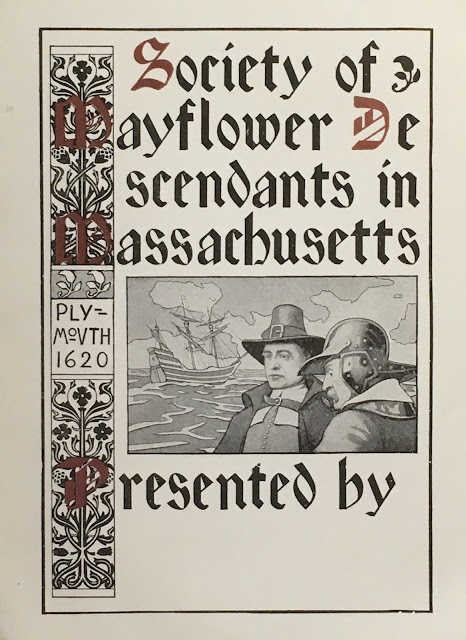In this case, it's the ex libris, or bookplate: an interesting testimonial to evolving habits of book ownership, and since the late nineteenth century, a profitable and collectible small graphic genre (1, 2) in its own right.
This one was created by the Massachusetts Society of Mayflower Descendants (not my ancestors, God knows--though I do know more than one student who can claim membership in that elite club). Founded in 1896, the organization soon decided that it needed an ex libris to accompany donations it made.
An "American Letter" by Charles Dexter Allen of Hartford (Nov. 9, 1897) in the British Journal of the Ex Libris Society announced a competition:
The Society of Mayflower Descendants offers two prizes, one of fifty dollars and the other of twenty dollars, for a book-plate design. The plate is to be 4 1/2 by 3 inches, and the design in the centre should be 2 1/4 by 1 3/8 inches. Above this should be the title, "Society of Mayflower Descendants in Massachusetts," and at the bottom, "Presented by," with space for date and name of donor. The office of the Society is in the Tremont Building, Boston.
The following year, Allen reported on the winners. He began with an apology for his long silence:--Vol. 7 (1897): 178-79, quotation from 178
So many months have gone by without a communication from the American correspondent, that I feel assured these present lines will be read as a decided novelty, and I am not certain that an introduction is not in order ! But really during the hot and hottest months there seemed little doing in matters of interest to book-plate collectors, though, in fact, discoveries were being made, new plates were being designed and engraved, and the ongo of matters was not wholly interrupted. But with the return of weather that makes one think of the fireside and indoor delights, correspondence is resumed and matters of general interest are passed about from one to another.He reported on the creation of the smallest bookplate in the world (for a miniature book), and then, not bothering with a transition, launched into an update on the Mayflower contest:
Within a few months a competition for a bookplate was advertised by the Society of Mayflower Descendants in Massachusetts, and at a meeting held last March the first prize, fifty dollars, was awarded to Mr. Charles E. Heil, of Jamaica Plain, and the second, twenty dollars, to Mr. Theodore Brown Hapgood, jun., of Boston. At this meeting the sixty-eight designs submitted in competition were exhibited. The successful design has been printed in black with red capitals, and makes a very showy appearance. The lettering is good, and the pictorial design represents two Puritans, one in the layman's dress and one in the soldier's, standing by the sea-shore. At a little distance rides the Mayflower. Mr. Hapgood's design, printed wholly in black, represents the Puritan and his wife en route to church along the bleak shore, gun on shoulder, and clad in the sombre habiliments of the day. The old-style lettering and ornamentation are very pleasing, and one is impressed with the spirit of the design, which is in complete harmony with the picture and with the traditions the Mayflower Society endeavours to keep alive.Heil (1870-1950), a member of the newly founded Boston Society of Arts and Crafts (1897; today, the oldest such organization in the nation) came to be best known for his ornithological painting and has been called a second Audubon. Hapgood (1871-1938), by contrast, devoted more time to the world of book art, from binding design, title pages, and illustrations, to the ex libris (along the way finding time for ecclesiastical vestments and other artistic pursuits).
--Journal of the Ex Libris Society, 8 (1898): 171-72; here 172
Below is Heil's winning design, from my small collection. The reddish ink has a metallic cast, which, viewed from some angles, causes it to reflect light. The back is gummed.
I might quibble with that. Even aside from the generally retrograde aesthetic (the minimal nod to modish art nouveau taste in the left marginal column notwithstanding) and corresponding social-political doctrines, the highlighting of the key initial letters on the left is bizarrely violated by the awkward breaking of the word, "Descendants." It is jarring, conflicts with the supreme principle of legibility.
Still, I am very glad to have this historically significant piece in my collection. I don't have a copy of the second-place design, but one day ... who knows?

No comments:
Post a Comment